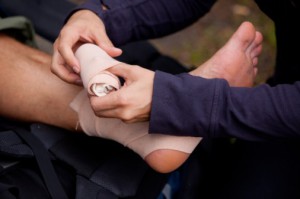 An ankle sprain occurs when you have stretched or torn the ligaments in your ankle. This is often caused by making too quick of a movement, which forces the joint out of its normal position.
An ankle sprain occurs when you have stretched or torn the ligaments in your ankle. This is often caused by making too quick of a movement, which forces the joint out of its normal position.
Ankle sprains can range from mild to severe, depending on how much damage has been done to the ligaments. Typically symptoms include:
- Swelling
- Bruising
- Pain
- Stiffness or restricted range of motion
- Redness or warmth in the area
If your symptoms are mild you can treat your injury by:
- Applying ice- This will help in reducing swelling and pain.
- Resting the ankle- This can be done by using crutches and keeping the affected leg elevated.
- Taking over the counter (OTC) painkillers- OTC painkillers such as ibuprofen are effective in managing pain and swelling.
- Applying compressions- Wrapping your ankle with adhesive bandages or wearing a brace will help reduce swelling and provide protection.
Typically mild sprains tend to last seven to ten days; however, if you are experiencing intense pain, abnormal swelling and are unable to place weight on your ankle, it is likely that your case is severe and needs immediate medical attention.
If left untreated severe ankle sprains can lead to chronic ankle instability, chronic pain and early onset arthritis. To reduce the risk of furthering your injury, schedule an appointment with your doctor if symptoms continue past 10 days.
Flushing Hospital Medical Center’s Division of Orthopedics is staffed with highly trained and respected doctors in their field. The division recently welcomed fellowship-trained surgeons, Drs. George Ackerman and Teo Mendez from Manhattan-based New York Orthopedics. Both physicians specialize in the treatment and surgical procedures of the knee, foot and ankle, shoulder, hip, and elbow, as well as sports-related injuries. They have worked extensively as team physicians for both professional and college sports teams. To schedule an appointment with an orthopedist at Flushing Hospital Medical Center, please call 718-670-5486.
All content of this newsletter is intended for general information purposes only and is not intended or implied to be a substitute for professional medical advice, diagnosis or treatment. Please consult a medical professional before adopting any of the suggestions on this page. You must never disregard professional medical advice or delay seeking medical treatment based upon any content of this newsletter. PROMPTLY CONSULT YOUR PHYSICIAN OR CALL 911 IF YOU BELIEVE YOU HAVE A MEDICAL EMERGENCY.
